

Mammal. Prototheria. Most of the animals in this group are extinct.
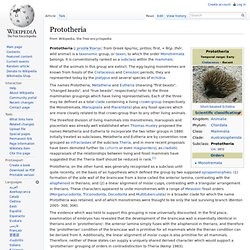
The egg-laying monotremes are known from fossils of the Cretaceous and Cenozoic periods; they are represented today by the platypus and several species of echidna. The names Prototheria, Metatheria and Eutheria (meaning "first beasts", "changed beasts", and "true beasts", respectively) refer to the three mammalian groupings which have living representatives. Each of the three may be defined as a total clade containing a living crown-group (respectively the Monotremata, Marsupialia and Placentalia) plus any fossil species which are more closely related to that crown-group than to any other living animals.
Trechnotheria. Trechnotheria is a group of mammals that includes the therians and some fossil mammals from the Mesozoic Era.
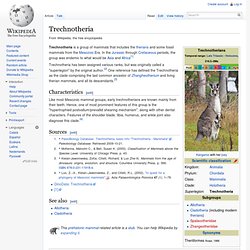
In the Jurassic through Cretaceous periods, the group was endemic to what would be Asia and Africa[1] Trechnotheria has been assigned various ranks, but was originally called a "superlegion" by the original author.[2] One reference has defined the Trechnotheria as the clade comprising the last common ancestor of Zhangheotherium and living therian mammals, and all its descendants.[3] Characteristics[edit] Like most Mesozoic mammal groups, early trechnotherians are known mainly from their teeth.
Hence, one of most prominent features of this group is the "hypertrophied postvallum/prevallid shearing mechanism", along with other dental characters. Sources[edit] Jump up ^ PaleoBiology Database: Trechnotheria, basic info "Trechnotheria - Mammalia". Holotheria. Holotheria is a diverse group of mammals.
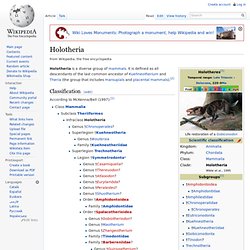
It is defined as all descendants of the last common ancestor of Kuehneotherium and Theria (the group that includes marsupials and placental mammals).[2] Classification[edit] According to McKenna/Bell (1997):[1] Cladotheria. Zatheria. Tribosphenida. Tribosphenida is a group (infralegion) of mammals that is defined as including the ancestor of Hypomylos, Necrolestidae, Aegialodontia and Theria (the last common ancestor of marsupials and placentals plus all of its descendants).

External links[edit] Theria. The earliest known therian mammal fossil is Juramaia, from the Middle Jurassic of China.
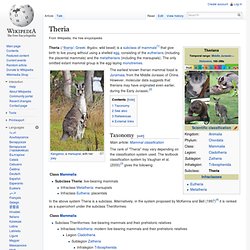
However, molecular data suggests that therians may have originated even earlier, during the Early Jurassic.[2] Taxonomy[edit] The rank of "Theria" may vary depending on the classification system used. The textbook classification system by Vaughan et al. (2000)[3] gives the following: In the above system Theria is a subclass. Another classification proposed by Luo et al. (2002)[5] does not assign any rank to the taxonomic levels, but uses a purely cladistic system instead. Metatheria. Evolutionary history[edit] The ancestors of marsupials, part of a larger group called metatherians, probably split from those of placental mammals (eutherians) during the mid-Jurassic period, though no fossil evidence of metatherians themselves are known from this time.[4] Fossil metatherians are distinguished from eutherians by the form of their teeth; metatherians possess four pairs of molar teeth in each jaw, whereas eutherian mammals (including true placentals) never have more than three pairs.[5] Using this criterion, the earliest known metatherian is Sinodelphys szalayi, which lived in China around 125 million years ago (mya).[6] This makes it a contemporary to some early eutherian species which have been found in the same area.[7]
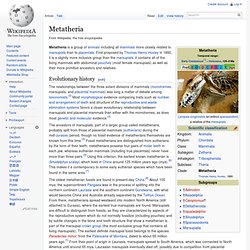
Marsupial. Marsupials represent the clade originating with the last common ancestor of extant metatherians.
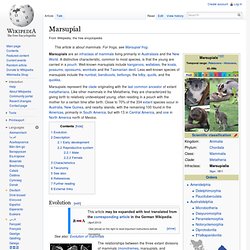
Like other mammals in the Metatheria, they are characterized by giving birth to relatively undeveloped young, often residing in a pouch with the mother for a certain time after birth. Close to 70% of the 334 extant species occur in Australia, New Guinea, and nearby islands, with the remaining 100 found in the Americas, primarily in South America, but with 13 in Central America, and one in North America north of Mexico. Evolution[edit] Dentition of the herbivorous eastern grey kangaroo, as illustrated in Knight's Sketches in Natural History. Australidelphia. Eutheria. Eutheria (/juːˈθɪəriə/; from Greek ευ-, eu- "true/good" and θηρίον, thērion "beast" hence "true beasts") is one of two mammalian clades with extant members that diverged in the Early Cretaceous or perhaps the Late Jurassic.
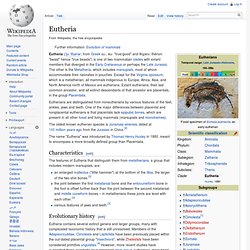
Placentalia. Placentalia is a group of mammals.

The majority of living mammals are placental: the other two living mammal groups are the Monotremata and the Marsupialia. The placentals are distinguished from other mammals in that the fetus is nourished during gestation via a placenta while, in general, this is not the case with other mammals (Bandicoots are an exception). Afrotheria. Afrotheria is a clade of mammals, the living members of which belong to groups currently living in Africa or that are of African origin: golden moles, sengis (also known as elephant shrews), tenrecs, aardvarks, hyraxes, elephants, and sea cows.

The common ancestry of these animals was not recognized until the late 1990s.[1] Historically, the Paenungulata had been linked to other ungulates; the golden mole, tenrecs, and elephant shrews with the traditional (and polyphyletic) Insectivora; and the aardvarks with the pangolins and the xenarthrans within the invalid taxon Edentata. Continuing work on the molecular[2][3] and morphological [4][5][6][7] diversity of afrotherian mammals has provided ever increasing support for their common ancestry.
Evolutionary relationships[edit] The afrotherian clade was originally proposed in 1998[1] based on analyses of DNA sequence data. Relations between the various afrotherian orders are still being studied. Current status and distribution[edit] Euarchontoglires. Euarchontoglires (synonymous with Supraprimates) is a clade (superorder) of mammals, the living members of which belong to one of the five following groups: rodents, lagomorphs, treeshrews, colugos and primates (including humans). Evolutionary relationships[edit] The Euarchontoglires clade is based on DNA sequence analyses and retrotransposon presence/absence data, combining the Glires clade, which consists of Rodentia and Lagomorpha, with that of Euarchonta, a clade consisting of Scandentia, Primates (which includes humans) and Dermoptera.
[citation needed] So far, few if any anatomical features supporting Euarchontoglires have been recognized, but neither is there strong evidence from anatomy to support alternative hypotheses. Euarchontoglires is now recognized as one of the four major groups within Eutheria (containing placental mammals).[1] These four clades are usually discussed without a Linnaean rank, but have been assigned the rank of cohort or magnorder, and superorder. Glires. Euarchonta. Euarchonta and Glires together form the Euarchontoglires, one of the four Eutherian clades. Note that as eu- becomes ev- before vowels in Latin, Euarchonta is not a proper Latin phonological construct—Evarchonta would be appropriate. This is applied inconsistently in English, for example in euergetism on one hand and evangelism on the other.
The current data situation be based on the molecular clock extrapolate that Euarchonta arose in the Cretaceous period about 88 million years ago and is already segregating 86.2 million years ago in the groups of tree shrews and Primatomorpha. References[edit] Jump up ^ Jan E. Murphy W. Paenungulata. Of the five orders, hyraxes are the most basal, followed by embrithopods; the remaining orders (sirenians, desmostylians and elephants) are more closely interrelated. These latter three are grouped as the Tethytheria, because it is believed that their common ancestors lived on the shores of the prehistoric Tethys Sea; however, recent myoglobin studies indicate that even Hyracoidea had an aquatic ancestor.[2] Although morphological evidence continues to support the position of paenungulates with the ungulates, the molecular evidence suggests that Paenungulata is part of the cohort Afrotheria, an ancient assemblage of mainly African mammals of great diversity.
Tethytheria. Tethytheria is a clade of mammals that includes the sirenians and the proboscideans and the extinct orders Desmostylia and Embrithopoda.[1] Systematics[edit] Cladogram after Rose 2006.[3] Boreoeutheria. Boreoeutheria (synonymous with Boreotheria) (Gk: βόρειο North + θεριό Beast) is a clade (magnorder) of placental mammals that is composed of the sister taxa Laurasiatheria (most hoofed mammals, most pawed carnivores, and several other groups) and Euarchontoglires (Supraprimates). It is now well supported by DNA sequence analyses, as well as retrotransposon presence/absence data. The earliest known fossils belonging to this group date to about 65 million years ago, shortly after the K-Pg extinction event, though molecular data suggests they may have originated earlier, during the Cretaceous period.[1]
Archonta. Primatomorpha. The term "Primatomorpha" first appeared in the general scientific literature in 1991 (K.C. Beard) and 1992 (Kalandadze, Rautian). Major DNA sequence analyses of predominantly nuclear sequences (Murphy et al., 2001) support the Euarchonta hypothesis, while a major study investigating mitochondrial sequences supports a different tree topology (Arnason et al., 2002). Laurasiatheria. Laurasiatheria is a large group of placental mammals believed to have originated on the northern supercontinent of Laurasia. Scrotifera. Zooamata. Fereuungulata. It is based on evidence from molecular phylogenetics.[1][2] Within Fereuungulata, Carnivora and Pholidota form the clade Ferae while Cetacea and Artiodactyla form Cetartiodactyla. There is uncertainty regarding the placement of Perissodactyla; a grouping with Ferae has been proposed as the clade Zooamata while a grouping with Cetartiodactyla has been proposed as the clade Euungulata ("true ungulates").
Ferae. According to recent studies (reflected in the diagram below), the closest relatives of Ferae are Perissodactyla (horses, tapirs and rhinos) and Cetartiodactyla (which combines Artiodactyla--camels, pigs, ruminants and hippos—with Cetacea--whales and dolphins).[2][3] An alternate phylogeny (less supported) holds that the closest relatives to Ferae are Perissodactyla and Chiroptera (bats), not Cetartiodactyla.[4] Ferae together with Perissodactyla has been called Zooamata. Carnivoramorpha. Cetartiodactyla. Cetruminantia. Whippomorpha. Xenarthra. Atlantogenata. Exafroplacentalia. Epitheria. Bird. Modern birds. Neognathae. Neoaves. Metaves. Cypselomorphae. Aequornithes. Actinopterygii. Actinopteri. Neopterygii. Teleostei. Acanthopterygii. Acanthomorpha. Arachnid. Dromopoda.